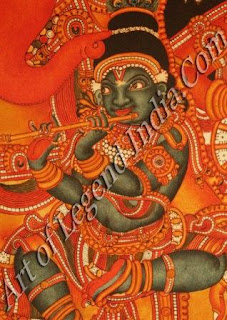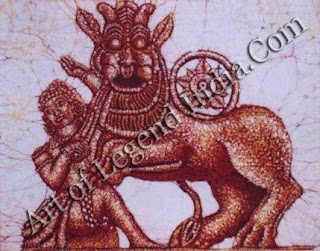 Yakshi Ambika, the most popular
in Jain art, is shown under the mango tree with her two children and a lion.
One of the boys rides the lion, while the other is very close to his mother.
The theme of devotees adoring Parsvanatha and Suparsvanatha is extremely
simple. Such themes, however, as Matanga Yaksha with his vehicle, the elephant,
seated with its head proudly lifted up, and the whole picture arranged with an
artistic background of trees, interesting for their conventional patterns, are
very pleasing. Srutadevi with her peacock or Mahamanasi with her swan and Yaks
ha Ajita on a tortoise are all delightful artistic creations of the Hoysala
painter's brush. The floriated tail of the bird and the delineation of the
contours of the figures reflect great artistic taste and creative talent.
Yakshi Ambika, the most popular
in Jain art, is shown under the mango tree with her two children and a lion.
One of the boys rides the lion, while the other is very close to his mother.
The theme of devotees adoring Parsvanatha and Suparsvanatha is extremely
simple. Such themes, however, as Matanga Yaksha with his vehicle, the elephant,
seated with its head proudly lifted up, and the whole picture arranged with an
artistic background of trees, interesting for their conventional patterns, are
very pleasing. Srutadevi with her peacock or Mahamanasi with her swan and Yaks
ha Ajita on a tortoise are all delightful artistic creations of the Hoysala
painter's brush. The floriated tail of the bird and the delineation of the
contours of the figures reflect great artistic taste and creative talent. Hoysala Emperor Eleventh to Thirteenth Century A.D.
Posted by
Art Of Legend India [dot] Com
On
2:33 AM
Vinayaditya was the first
important king, whose grand-son Bittideva or Bittiga was a mighty monarch. He
made the dynasty independent. Originally a Jain, he was con-verted to
Vaishnavism by Ramanuja in the twelfth century A.D. Now styled Vishnuvardhana,
the newly-converted king enthusiastically built beautiful temples and embellished
them with the finest art of the period under the inspiration of the great
religious reformer. The temple at Belur, a gem of Hoysala art, is his creation.
A striking portrait of the king, with his learned Jain queen Santala beside
him, is found on a carved lithic screen. Though the king changed his faith, he
was catholic in outlook and Jainism flourished equally during his time and
later. As in the case of the Ikshvaku sovereigns, who were of the Brahmanical
faith, with the princesses devoted to Buddha, here was a king, a devout
Vaishnavite, with his wife dedicated to the faith of the Tirthankaras. His
ministers and generals like Gangaraja and Hulli Dandanayaka were devout
followers of the Jain faith.
After Ballala II or Vira
Ballala, as he was known, and his sons Narasimha II and Somesvara, the Hoysala
kingdom slowly crumbled till it was dealt a death-blow by Alla-ud-din Khilji
through his general Malik Kafur.
Examples of architecture and
sculpture all over Mysore have revealed a magnificent sculptural wealth of the
Hoysalas. No examples of the painter's art were known so far. Though no murals
have been noticed in any of the temples, fortunately there are specimens of
Hoysala painting preserved in Moodbidri. These are painted palm-leaf
manuscripts at this pontifical seat. They compose the com-mentaries of Virasena
known as Dhavala and Jayadhavala and Mahadhavala or Mahabandha of the original
text of Shatkhandagama.
It is fortunate that these
manuscripts, with the palaeography, clearly Hoysala, of the time of
Vishnu-vardhana, with paintings in bright colours of great charm, shouled have
survived, thanks to the institution at Moodbidri, to give us an idea of the art
of the Hoysala painter. It is interesting to compare with the writing in these
manuscripts the letters composing the flowery lines in the metal plates from
the Belur temple. The sweeping lines composing the letters are characteristic
of both.
These paintings should be
attributed to the time of Vishnuvardhana and his wife Santala who was so devoted
to Jainism. These paintings are in bright colours on unusually large
palm-leaves, which are important both for the beauty of the letters composing
the text and for the illustrations that accompany it. Two of the leaves with
letters rather thickened, with a greater delicacy than in the case of the rest,
with a soft tone reducing all effect of contrast in colours, and with the
outline drawn in very pleasing pro-portions, appear the earliest among these
paintings. This manuscript of Dhavala is dated A.D. 1113. Here is presented the
Yakshi Kali of Suparsvanatha who, however, is of fair complexion. The bull, her
vehicle, is also present. The flexion of her body and the sinuous lines
composing the figures are remarkable. Similarly, the royal devotees on one
side, the king, queen and the prince, are drawn and painted with great
delicacy. These are towards the end of the leaves. The central paintings in
both the leaves are a standing and a seated Tirthankara Mahavira. Though it is
very difficult to handle a theme so simple as that of a figure in the nude like
the Tirthankara, the painter has made both these creations truly artistic. The
lovely seat with a makara-decorated back and rearing lions is matched by the
fine chauri-bearers on either side in pleasing proportions and flexions. This
painting at once recalls the masterpiece of early Chola workman-ship in the
Nagapattinam Buddha with Nagaraja chauri-bearers on either side. It is almost
monochrome here, but it has a wonderful effect as a painting with depth brought
out with great mastery.
One end of one of the other
leaves presents Parsvana tha with snake-hoods over his head seated on a
lion-throne with chauri-bearers flanking, and with Dharanendra Yaksha on one
side and Padmavati Yakshini on the other. One end of another leaf shows
Srutadevi in the centre, flanked by elegant female chauribearers, whose body
flexion, coiffure, turn of face and twist of neck and crossing of the legs are
all very pleasing. An almost similar and equally effective one is towards
another end of a leaf. In the same style but somewhat simple is represented the
theme of Bahubali who turned an ascetic and allowed creepers to grow and
en-twine around his legs. His sisters flanking him are almost as in the panel
at Ellora depicting the same theme.
 Yakshi Ambika, the most popular
in Jain art, is shown under the mango tree with her two children and a lion.
One of the boys rides the lion, while the other is very close to his mother.
The theme of devotees adoring Parsvanatha and Suparsvanatha is extremely
simple. Such themes, however, as Matanga Yaksha with his vehicle, the elephant,
seated with its head proudly lifted up, and the whole picture arranged with an
artistic background of trees, interesting for their conventional patterns, are
very pleasing. Srutadevi with her peacock or Mahamanasi with her swan and Yaks
ha Ajita on a tortoise are all delightful artistic creations of the Hoysala
painter's brush. The floriated tail of the bird and the delineation of the
contours of the figures reflect great artistic taste and creative talent.
Yakshi Ambika, the most popular
in Jain art, is shown under the mango tree with her two children and a lion.
One of the boys rides the lion, while the other is very close to his mother.
The theme of devotees adoring Parsvanatha and Suparsvanatha is extremely
simple. Such themes, however, as Matanga Yaksha with his vehicle, the elephant,
seated with its head proudly lifted up, and the whole picture arranged with an
artistic background of trees, interesting for their conventional patterns, are
very pleasing. Srutadevi with her peacock or Mahamanasi with her swan and Yaks
ha Ajita on a tortoise are all delightful artistic creations of the Hoysala
painter's brush. The floriated tail of the bird and the delineation of the
contours of the figures reflect great artistic taste and creative talent.
Even the borders in these
manuscripts reveal great taste and elegance. Though innumerable floral patterns
have been exclusively painted on other leaves, there is no repetition anywhere.
Writer
– C. Sivaramamurti
Subscribe to:
Post Comments (Atom)













0 Response to "Hoysala Emperor Eleventh to Thirteenth Century A.D."
Post a Comment